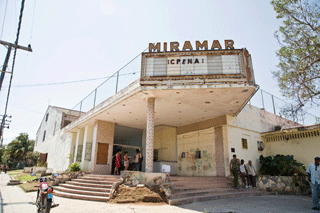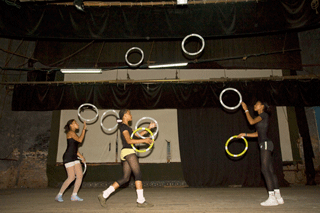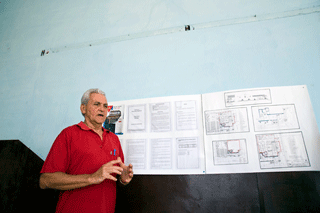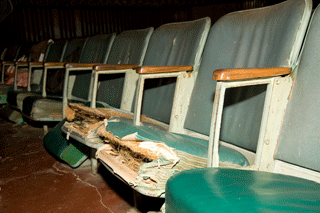Miramar theatre and the people who use it
The somewhat neglected looking exterior of Teatro Miramar, with it’s peeling paintwork and sign with missing letters bears witness to years of neglect due to lack of resources for its care and upkeep. This looks set to change however, once an ambitious renovation project gets underway, thanks to a fundraising project launched by the Music Fund for Cuba.
Built in the 1950’s, the 600-seat theatre was still in use as a cultural centre for the local community until around 18 years ago, but the collapse of the Soviet Union as one of Cuba’s main trading partners, coupled with the US economic blockade made it impossible to obtain the equipment needed for essential repair work to the theatre.
I visited Teatro Miramar in March this year, to photograph the interior of the theatre for the fund-raising project and to find out more about the planned renovation work. When we meet Theatre Director Juvenal Garcia Beato, his enthusiasm and vision for the theatre transforms the shabby interior with its broken seats into the thriving hub of artistic activity that it was once was and no doubt will be again once the renovation work is completed.
At the theatre we meet Emilio Sobrino, Deputy Director of the National Circus school; Arlene Ramirez, Deputy Director of the National Dance school, and Odalys Villavicencio Valls, Deputy Director of the Music school. Emilio outlines his hopes that Teatro Miramar can become the main venue used by the Circus school as the focus for community related projects.
The renovation work will include enlarging the stage; improving the lighting, and adding a video screen and all the necessary fittings to enable circus performances to take place in the theatre. It is hoped that international festivals will also take place here.
Emilio’s hopes are echoed by three circus students who are practising on the stage; space is currently an issue at all of the performing arts schools, and the students currently use the theatre as a rehearsal space. They are excited about the prospect of the site adjoining the theatre being transformed into a dedicated practice area for circus and dance performers, and of performing on the stage of the theatre itself in front of live audiences.
Arlene Ramirez, Deputy Director of the National Dance school describes how she used to dance in this theatre in the 1980’s, and sets out her vision of the theatre as an ‘espacio ideal’ (ideal space) for all the arts schools in Havana. The dance school currently has very limited space and time for rehearsals, practice and performance, and the ability to perform more regularly in public will give the students the opportunity to develop a stronger relationship with audiences than they are currently able to.
Odalys Villavicencio Valls, Deputy Director of the Music school actually graduated in Teatro Miramar, and explains the importance of public performances in the graduation process for all music students. Each of the 80 – 100 students that graduate each year must perform in front of an audience at the end of their course, and one of the key aims of the restoration of the theatre is to facilitate the development of this relationship between the students and the community. The space currently available at the school is too small to enable the students to really undertake public performances on a large scale, and the restoration of the theatre will provide them with this invaluable resource.
One of the projects Odalys is currently working on is a community project involving youth choirs, and she hopes that this type of community based project will benefit greatly from the renovation of the theatre.
Interaction with the community has been a theme running through all of our discussions around the potential for the theatre, and Adriano Hernandez, Productora Cultural del Teatro explained more about the vision of the theatre as a future centre for community based arts projects and international cultural exchanges.
An exchange project between dance students from Cuba and Holland has already taken place in the last four years, using the theatre as its base, and a community project entitled ‘Raices’ (‘Roots’) is currently underway involving children from the local community. The project focuses on traditional Cuban dance, and on enabling the children involved to develop a sense of their own diverse cultural heritage.
The initial phase of the renovation project is expected to start this year, with the roof of the theatre and other essential structural repairs, including the seats, lighting system and the stage itself. The main objective of this first phase will be to restore, as far as possible, the normal functioning of the theatre.
The second phase (expected to take place next year, 2010) will involve renovating an adjoining building to form the rehearsal and practice spaces needed by the various artists and students who will be using the theatre.
Clearly a huge amount of work, time and resources will be required to transform this vision into reality. However, if the passion, enthusiasm and commitment shown by Director Juvenal Garcia Beato and his colleagues is any indication, this dream will become a reality, and I look forward to attending performances in the newly transformed Teatro Miramar in the not too distant future.
© Alice Mutasa 2009 http://www.placesandseasons.org.uk





